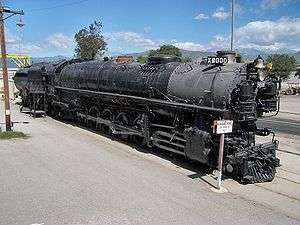4-12-2
| Union Pacific 9000-series | |||||||||||||||||||||||||||||||
|---|---|---|---|---|---|---|---|---|---|---|---|---|---|---|---|---|---|---|---|---|---|---|---|---|---|---|---|---|---|---|---|
 The prototype, UP 9000, as preserved at the Los Angeles County Fairplex in Pomona, California. | |||||||||||||||||||||||||||||||
| |||||||||||||||||||||||||||||||
| |||||||||||||||||||||||||||||||
| |||||||||||||||||||||||||||||||
| |||||||||||||||||||||||||||||||

Under the Whyte notation for the classification of steam locomotives, 4-12-2 represents the wheel arrangement of four leading wheels, twelve coupled driving wheels, and two trailing wheels. This arrangement was named the Union Pacific type, after the only railroad to use it.
Other equivalent classifications are:
AAR wheel arrangement: 2-F-1
UIC classification: 2′F1′ (also known as German classification and Italian classification)
French classification: 261
Turkish classification: 69
Swiss classification: 6/9
Only one type of 4-12-2 was built: the Union Pacific Railroad's 9000-series locomotives, 88 of which were built by ALCO between 1926 and 1930. These locomotives were used to increase the speed of freight trains in flat country, and were fairly successful, but were maintenance nightmares, largely because of their use of an inside third cylinder driving the cranked second driving axle between the frames. There was no inside valve gear to worry about, however. ALCO had obtained permission to use the conjugated valve gear invented by Sir Nigel Gresley. This system used two hinged levers connected to the outer cylinder's valves to operate the inner cylinder's valve. The 9000 class locomotives were the largest to use Gresley gear.
Between 1934 and 1940 eight of the first fifteen locos had their Gresley gear removed and were converted to a "double Walschaerts" valve gear which utilized a double eccentric (return) crank and second link on the right side (similar to the gear Baldwin used on its 3-cylinder experimental compound 4-10-2 #60000), which operated the valve for the inside cylinder. Union Pacific referred to this system as the "third link." The 4-12-2's constructed from 1928 utilized roller bearings in the Gresley lever bearings, thus none of these engines were converted. The pre-1928 engines not converted received the roller bearing levers in 1940, and no further conversions were made.
During design the third and fourth driving axles were planned to be "blind" (flangeless) in order to improve curve handling, but ALCO's lateral motion devices on the first and sixth axles (which allowed the axles to slide up to two inches to the side) made this unnecessary. They had the longest rigid wheelbase in North America, and the longest in the world until the Soviet Union built their 4-14-4 locomotive in 1934. The trailing truck carried the same axle load as the drivers, which was unusual.
There has been debate as to whether the first driving axle of the 4-12-2 was cranked to provide clearance for the main rod connected to the second axle. Union Pacific drawings show no such crank on the first axle, and the Railway Age article says "The 67 in (170 cm) drivers permit the use of a straight axle on the front drivers..." The spacing between the first and second axles was increased by 18 in (46 cm) to provide clearance. Based on the published dimensions, this means at its closest the centerline of the inside rod was 11.645 in (29.58 cm) from the centerline of the first axle. (UP drawings reproduced in Kratville and Bush's "Union Pacific Type" books show the inside rod 113 in (290 cm) long and the first and second driver axles 88 in (220 cm) apart. The inside cylinder axis was inclined 9.5 degrees and was 32 in (81 cm) above the plane of the driving axles at a point 181 in (460 cm) ahead of the second driving axle, so the cylinder axis missed the centerline of the second axle by 1-11/16 inches. The rod centerline is closest to the axle when the crank is 54.49 degrees below horizontal.)
| Year | Quantity | Class | Builder | Union Pacific Number | Notes |
|---|---|---|---|---|---|
| 1926 | 1 | UP-1 | Alco 66544 | Union Pacific 9000 | Preserved |
| 1926 | 14 | UP-2 | Alco | Union Pacific 9001–9014 | 9004 to OWR&N 9708, then back to UP 9004 |
| 1928 | 15 | UP-3 | Alco | Union Pacific 9015–9029 | |
| 1928 | 8 | UP-3 | Alco | Oregon-Washington Railroad and Navigation Company 9700–9707 | to Union Pacific 9055–9062 |
| 1929 | 25 | UP-4 | Alco | Union Pacific 9030–9054 | |
| 1930 | 15 | UP-5 | Alco | Union Pacific 9063–9077 | to Oregon Short Line 9500–9514 |
| 1930 | 10 | UP-5 | Alco | Union Pacific 9078–9087 | |
| Total | 88 | ||||
One example survives: Union Pacific 9000 (seen at right) at the Railway and Locomotive Historical Society's museum at the Los Angeles County Fairplex in Pomona, California.
References
- Three Cylinder Steam locomotives maintained by Wes Barris
- Drury, George H. (1983), Guide to North American Steam Locomotives, Waukesha, Wisconsin: Kalmbach Publishing Company, pp. 397–398, 404, ISBN 0-89024-206-2, LCCN 93041472
- Hollingsworth, Brian (2000). The Illustrated Dictionary of Trains of the World. London: Salamander Books Ltd. ISBN 1-84065-177-6.
- Kratville, William W.; Bush, John E. (1990). The Union Pacific Type, Vol. 1. Omaha, Nebraska: Barnhart Press. LCCN 90082171.
- Kratville, William W.; Bush, John E. (1995). The Union Pacific Type, Vol. 2. Omaha, Nebraska: Barnhart Press. LCCN 90082171.
- Westcott, Linn H. (1960). Model Railroader Cyclopedia - Volume 1: Steam Locomotives. Kalmbach Books. ISBN 0-89024-001-9.